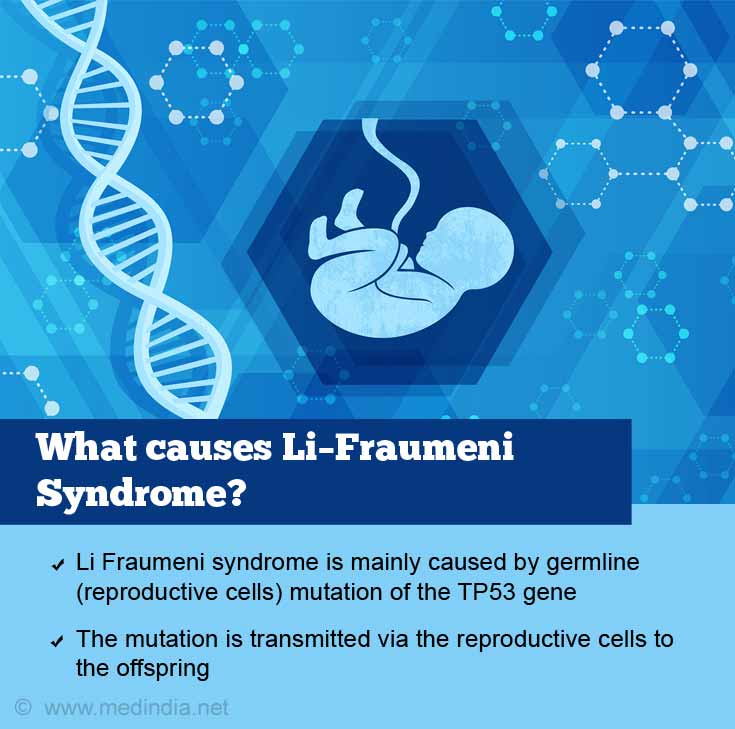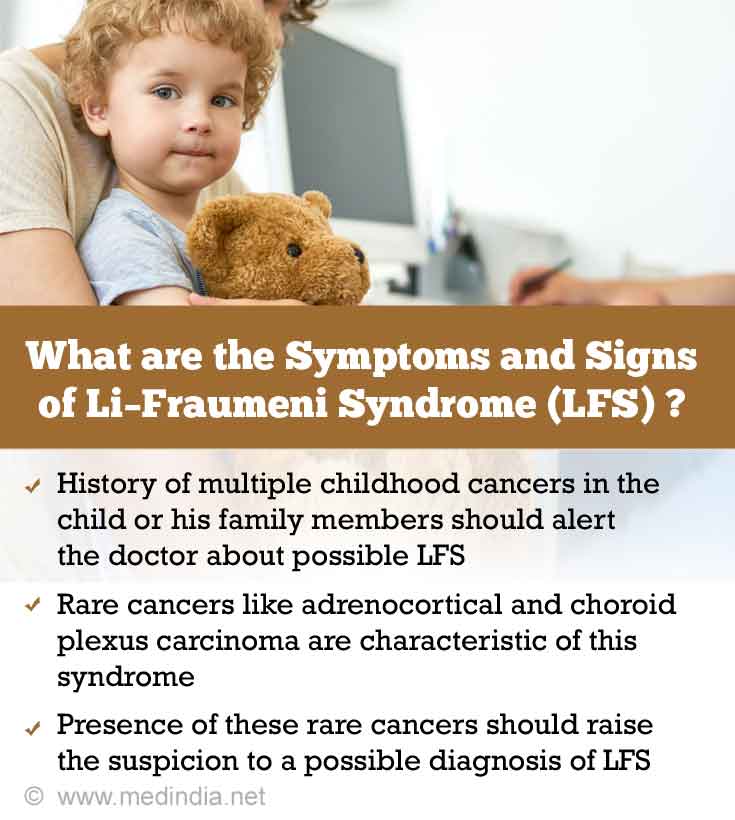- What Is Lfs? | Li-Fraumeni Syndrome Association - (https://www.lfsassociation.org/what-is-lfs/)
- Li-Fraumeni syndrome - (https://en.wikipedia.org/wiki/Li%E2%80%93Fraumeni_syndrome#Epidemiology)
- Li-Fraumeni Syndrome - General Discussion - (https://rarediseases.org/rare-diseases/li-fraumeni-syndrome/)
- Family Cancer Syndromes - (https://www.cancer.org/cancer/cancer-causes/genetics/family-cancer-syndromes.html)
What is Li–Fraumeni Syndrome?
Li Fraumeni syndrome (LFS) is a type of inherited cancer syndrome. In this condition, the increased risk for developing certain types of cancers runs in families. The cancers tend to occur at a younger age compared to the general population.
It is extremely rare and till date the condition has been identified in 1000 families (comprising many generations in each) worldwide. Inquiries on the LFS association website have received responses from about 172 countries so far.
LFS was first described in 1969 by Drs. Frederick Li and Joseph Fraumeni, Jr., while working on childhood and familial cancers at the National Cancer Institute. They described four families having a history of several early-onset cancers in childhood and teens. In 1982, scientists in the UK were the first to term the condition “Li-Fraumeni syndrome” in a publication where they described two families with multiple forms of cancer in young individuals.
In a major /peakthrough in 1990, inherited (or germline, see below for explanation) mutations of TP53 tumor suppressor gene were discovered as the primary cause of LFS. This finding provided a unique opportunity for genetic testing that allowed early detection, treatment and prevention of tumors in persons with LFS. The recognition of LFS fuelled several research projects into TP53 gene, to try and understand its function better.
Interestingly non-inherited or somatic cell (non-reproductive cells which are not passed to offspring) mutations of the TP53 gene have been found to be associated with sporadic (in the general population, not hereditary) cancers as well.
What are the Causes of Li–Fraumeni Syndrome?
The cause for Li Fraumeni syndrome is due to a germline (related to gametes/reproductive cells) mutation of the TP53 gene. This means that the TP53 gene mutation occurs in the reproductive cells (egg or sperm). Consequently, the mutation is transmitted via the reproductive cells to the offspring.

- Thus, the Li Fraumeni syndrome is an example of a hereditary (inherited) cancer syndrome associated with an increased risk of getting certain cancers, particularly at a young age, in affected families.
- Nearly 70% of Li-Fraumeni syndrome families and 40% of Li-Fraumeni–like families have germline mutations in the TP53 tumor suppressor gene.
- About 767 types of germ line mutations have been identified.
- Li Fraumeni syndrome is inherited as an autosomal dominant condition which means that having one copy of the defective gene (out of 2 copies, namely one from each parent) is sufficient for the person to develop the disease.
- Most individuals with LFS have a germline TP53 gene mutation, but rarely, LFS is due to a spontaneous (de novo) genetic mutation in the egg or sperm cell. In this situation, the syndrome is not inherited from the parents.
- Individuals with LFS have an increased risk of developing cancers associated with certain lifestyle or environmental exposures, such as radiation exposure, sunlight or tobacco smoking, and should take adequate preventive measures to reduce these exposures.
- A variant of Li-Fraumeni syndrome (although disputed) can be caused by mutations in another tumor suppressor gene called CHEK2, which normally prevents cells with DNA damage from multiplying.
What are the Symptoms and Signs of Li–Fraumeni Syndrome?
LFS should be considered if someone has a personal or family history of cancers known to occur in LFS. History of multiple childhood cancers in a patient or his family members should alert the physician about possible LFS. Additionally, there are certain rare cancers such as adrenocortical and choroid plexus carcinoma that are characteristic of the syndrome that should raise the clinical suspicion to a possible diagnosis of LFS.
Cancers most commonly associated (core cancers) with LFS include -
- Soft tissue sarcoma
- Osteosarcoma
/peast cancer - /pain and central nervous system (CNS) tumors (glioma, choroid plexus carcinoma, sonic hedgehog subtype medulloblastoma, neuroblastoma)
- Acute leukemia
- Adrenocortical carcinoma
- Lung adenocarcinoma
- Melanoma (skin cancer)
- Gastrointestinal cancers (such as colon, pancreas)
- Renal cancer
- Thyroid
- Gonadal germ cells (such as ovarian, testicular, and prostate)
Persons with LFS have a roughly 50% of developing cancer by 40 years, and nearly 90% percent chance by 60 years. Females have nearly a 100% risk of getting cancer in their lifetime due to their significantly increased risk of /peast cancer. Many individuals with LFS in fact develop two or more primary cancers during their life.

How do you Diagnose Li–Fraumeni Syndrome?
Diagnosis of Li-Fraumeni syndrome is based on clinical criteria and/or genetic testing for the mutation in the TP53 gene. Genetic testing is typically considered when a combination of the criteria outlined below are satisfied.
Diagnosis of Classic LFS (all 3 criteria to be present) – proposed by Li et al 1988
- Sarcoma diagnosed before 45 years
- First-degree relative, i.e. a parent, sibling or child, diagnosed with any cancer before 45 years
- First-degree relative or second-degree relative (grandparent, aunt/uncle, niece/nephew, or grandchild) with a diagnosis of any cancer before 45 years or a sarcoma at any age
Chompret Criteria for Clinical Diagnosis of Li-Fraumeni Syndrome (updated in 2015) (Bougeard et al., 2015)
These are a recently described set of criteria proposed to identify families not falling under the Classic criteria listed above. A diagnosis of LFS and performing TP53 gene testing is considered in anyone with a personal and family history of any 1 of the following 3 criteria.
Criterion 1 – Familial Presentation
- Person with tumor belonging to the LFS spectrum, before 46 years including soft-tissue sarcoma, osteosarcoma, lung cancer, leukemia, pre-menopausal /peast cancer, /pain tumor, adrenal cortical carcinoma and
- At least one first or second-degree relative with LFS tumor (except /peast cancer if patient has /peast cancer) before 56 years or with multiple cancers
Criterion 2 – Multiple Primary Tumors
- Person with multiple tumors (except multiple /peast cancers), at least two of which belong to LFS tumor panel and first cancer occurring before 46 years
Criterion 3 - Rare tumors
- Patient with specific rare cancers such as adrenocortical carcinoma, rhabdomyosarcoma em/pyonal anaplastic subtype or choroid plexus tumor irrespective of family history
Li Fraumeni like Syndrome (LFL)
A diagnosis of Li Fraumeni like syndrome is considered in persons who do not meet the above defined criteria
LFL Definition 1, called the Birch definition (all 3 to be present)
- Person diagnosed with any childhood cancer, sarcoma, /pain tumor, or adrenocortical malignancy before 45 years and
- First-degree or second-degree relative diagnosed with any LFS spectrum cancer, such as sarcoma, /peast cancer, leukemia, /pain cancer, adrenal cortical tumor, at any age and
- First-degree or second-degree relative diagnosed with any cancer before 60 years
Two first-degree or second-degree relatives diagnosed with a typical LFS malignancy, such as sarcoma, adrenocortical cancer, /peast cancer, /pain cancer, or leukemia, at any age.
How do you Treat Li–Fraumeni Syndrome?
STANDARD MANAGEMENT
Treatment of Diagnosed Cancers
Currently there is no standard treatment or cure for LFS. Most people with LFS who develop cancers are treated in the same manner as for cancers in other patients, but research is ongoing on how to best manage cancers related to LFS.
Surveillance and Imaging – for early detection and treatment of new cancers
| Children (birth to age 18 years) | Adults |
|
|
Note - For families where breast cancer has already occurred when they are about 20 years of age, awareness and screening can be considered 5 to 10 years before the earliest recorded age of onset. The same is recommended for gastrointestinal cancers i.e. consider screening 5 years before the earliest record of onset of a gastrointestinal cancer in a family. member.
Precautions to avoid certain exposures
Radiation treatment of cancers in LFS should be usually avoided since radiation exposure in these persons increases their risk for other cancers. However, if the benefits outweigh the risks it should be given with caution. Other exposures to avoid include tobacco and sunlight.
INVESTIGATIONAL TREATMENTS
Several studies exploring the use of agents that reactivate or modify dysfunctional TP53 protein are being actively pursued, but none have reached the stage of clinical trials in LFS patients.







